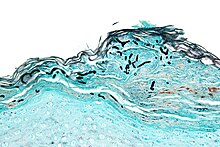| Dermatomycosis | |
|---|---|
 | |
| Micrograph of a superficial dermatomycosis. The fungal organisms are the dark staining, thick, quasi-linear objects below with skin surface. Vulvar biopsy. GMS stain. | |
| Specialty | Infectious diseases |
| Symptoms | These fungal infections impair superficial layers of the skin, hair and nails. |
A dermatomycosis is a skin disease caused by a fungus.
The most frequent form is dermatophytosis (ringworm, tinea). Another example is cutaneous candidiasis. These fungal infections impair superficial layers of the skin, hair and nails.
Literature
- Pietro Nenoff, Constanze Krüger, Gabriele Ginter-Hanselmayer, Hans-Jürgen Tietz (2014) Mycology – an update. Part 1: Dermatomycoses: Causative agents, epidemiology and pathogenesis
References
External links
| Classification | D |
|---|
| Fungal infection and mesomycetozoea | |||||||||||||||||||||||
|---|---|---|---|---|---|---|---|---|---|---|---|---|---|---|---|---|---|---|---|---|---|---|---|
| Superficial and cutaneous (dermatomycosis): Tinea = skin; Piedra (exothrix/ endothrix) = hair |
| ||||||||||||||||||||||
| Subcutaneous, systemic, and opportunistic |
| ||||||||||||||||||||||
| Mesomycetozoea | |||||||||||||||||||||||
| Ungrouped | |||||||||||||||||||||||
This cutaneous condition article is a stub. You can help Misplaced Pages by expanding it. |